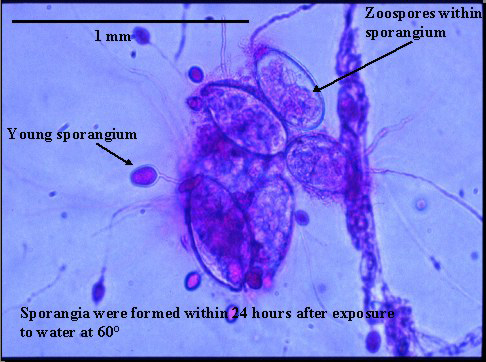| Sudden oak death |
 |
|
|
 |
| Phytophthora ramorum |
|
Phytophthora ramorum is a pathogen of regulatory concern in North America and Europe. The disease is established in 14 coastal counties in California and has been detected in Curry County, Oregon. In 2004, P. ramorum was detected in a few large wholesale nurseries on the West Coast that shipped potentially infected plants throughout the United States. In response, the USDA Animal and Plant Health Inspection Service (APHIS) adopted federal regulations requiring the inspection and certification of West Coast nursery stock as free of P. ramorum.
Oregon has over 2,100 wholesale nursery and greenhouse operations that generate almost $1 billion annually in gross sales. Over 80 percent of the nursery stock produced is exported. Many of these nurseries have multiple growing sites throughout the state. Each growing site with P. ramorum susceptible plants present must be inspected and tested for this disease.
|
|
 |
| Hosts and symptoms |
|
APHIS currently recognizes more than 100 plant species as being naturally susceptible to P. ramorum and thus subject to federal regulation. Several more plant species have been shown to be susceptible to infection in laboratory studies. Susceptible plants are divided into natural hosts, ones for which Koch´s Postulates have been completed, and associated hosts, ones for which Koch´s Postulates are yet to be completed.
APHIS maintains a complete list of all regulated and associated hosts for P. ramorum. (pdf 72 kb) This list is updated constantly as new hosts are added.
Several diagnostic guides are now available for this pathogen. Copies are available from the California Oak Mortality Task Force. The Oregon State University Extension Service in cooperation with others has also produced guides for Oregon nursery growers (pdf 537 kb) and for forest managers, Christmas tree growers, and forest-tree nursery operators (pdf 972.7 kb) interested in P. ramorum.
|
|
 |
| Disease movement |
|
Researchers are studying how P. ramorum spreads. Natural spread occurs through the movement of P. ramorum spores through the air. The pathogen needs moisture to produce spores. Once the spores are produced, they are then spread by the wind. Wind-driven rain is ideal for natural spread. P. ramorum has also been isolated from stream water and soil, although the exact roles these play in disease spread is yet to be determined. Humans moving infested plants have been responsible for some of the long distance spread of this disease. This is often referred to as "artificial" spread. Quarantines have been adopted by Oregon, California, and APHIS to prevent this artificial spread.
|
|
 |
| Spores |
|
In Oregon, P. ramorum is a clonal population. It reproduces asexually by forming zoospores and chlamydospores. Zoospores are produced inside sacs called sporangia. The sporangia can break off and be blown around by the wind. Under the right conditions, they germinate and infect hosts directly or they produce zoospores. The zoospores are short-lived and motile. They can swim several feet through water or water films to infect a susceptible host. A single spore is capable of starting an infection (i.e., canker).
Chlamydospores are specialized spores that allow the pathogen to survive environmental extremes. Laboratory experiments have demonstrated that P. ramorum chlamydospores are very drought resistant, although they do not tolerate high temperatures (i.e., over 115 degrees F) as well . Chlamydospores of other Phytophthora species have been known to survive for 2-6 years in infected plant debris or soil.
Phytophthora ramorum prefers cool, wet conditions. Temperatures between 50 and 65 degrees Fahrenheit are ideal. High moisture levels also favor this pathogen. In fact, moisture must be present for P. ramorum to produce sporangia.

|
|
 |
| Exclusion & control strategies |
|
APHIS has adopted an interim federal quarantine to prevent the artificial spread of P. ramorum to other parts of the U.S. The Oregon Department of Agriculture has adopted two regulations related to P. ramorum; the Phytophthora ramorum-Free Certification Program for Nurseries and the Phytophthora ramorum quarantine. (pdf 65.4 kb) Several of Oregon's trading partners, including Canada, California, and others, have also adopted quarantines to protect their horticultural and natural resources from P. ramorum. Compliance with these regulations is critical to prevent further artificial spread of this disease.
Oregon's oaks, tanoaks, huckleberries, rhododendrons and other plant species can best be protected by preventing further introductions of the disease to Oregon.
- Do not transport oak firewood or other potentially infected plant materials from diseased areas in California to Oregon.
- Do not import potentially infected plant materials from Europe.
- If you visit diseased areas, wash your vehicle and shoes before traveling to disease-free areas. This includes mountain bikes ridden in areas with the disease. Pet's feet should also be washed.
- If you see a host plant with suspicious disease symptoms, report it to the Oregon Dept. of Forestry immediately. You may also call a toll-free hotline (1-866-INVADER) to make a report.
The ODA, in cooperation with other state and federal agencies and the landowners involved, is attempting to eradicate P. ramorum in Curry County and in any nurseries or other locations where this pathogen is detected. Compliance with Oregon´s regulations for P. ramorum will be an integral part of the success of these eradication programs.
|
|
|
|